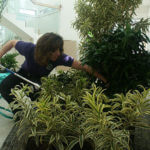Posts Tagged ‘how to’
Mother’s Day #LoveFromDetroit
Facebook Linkedin Twitter Pinterest The story behind the greenwalls at Shinola stores nationwide. The live plant backdrop highlights the genuine Shinola products at this store. This Mother’s Day, all Shinola storefronts are adorned with greenwalls of live plants and azaleas by Detroit based designer, Sarah Stalker, creative director of Planterra. The display of spring freshness…
Read MoreHow to Keep Plants Pest-free Indoors
Facebook Linkedin Twitter Pinterest Using Integrated Pest Management for indoor plantscapes When working with live plants, inside or out, management of pests is paramount to success. Integrated Pest Management (IPM) is a long-term effective and environmentally sensitive practice to maintain healthy live plants.It is supported by the Environmental Protection Agency. Indoor plants are susceptible to…
Read MoreWhat is the Best Topdressing for Interior Plants?
Facebook Linkedin Twitter Pinterest Topdressing for Interior Plantscapes Walk into any office or public building and you might not immediately notice the topdressing chosen for surrounding plants. A lot of planning goes into details like topdressing, the staging material that covers the soil surface of any potted plant. Indoor Plantscaping is Different Most plantscapes incorporate…
Read More


